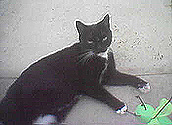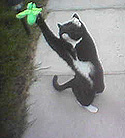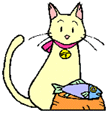Table of Contents
Assist Feeding – Constipation: Dennis’ Story
Feline Nutrition – The Ailing Cat
Pro-Active Cat Care – The Little Things
Feline Obesity – Nervous Cats
Kitty Potpourri – My Achin’ Bones
Assist Feeding – Constipation: Dennis’ Story
by Carole Blakeley ![]()
 My female cat Dennis has always had a good appetite but over a few weeks time she just licked her food, tried to eat a bit then spit it out. I looked in her mouth but couldn’t see anything… she wasn’t dribbling or anything. Dennis was off her food for about a week, but she was still eating a little and seemed ok in herself. I thought about worming tablets but I did not see evidence of worms. I gave her tuna and ham and she wouldn’t eat that either.
My female cat Dennis has always had a good appetite but over a few weeks time she just licked her food, tried to eat a bit then spit it out. I looked in her mouth but couldn’t see anything… she wasn’t dribbling or anything. Dennis was off her food for about a week, but she was still eating a little and seemed ok in herself. I thought about worming tablets but I did not see evidence of worms. I gave her tuna and ham and she wouldn’t eat that either.
The second week I noticed she ate even less.
I booked her in to the vets and he said she was severely constipated. He gave her some type of cream up her bottom (ouch) and said if she had not passed anything or eaten anything in a few days to bring her back in.
A few days later, no joy. She still had not been to the toilet and was very miserable… just sleeping a lot… dry nose… hard belly and un-playful… and she is normally up to all sorts. When I took her back to the vets, they said she needed to be knocked out and given an enema (Yuk) to clear the blockage. The vet explained that it may be difficult as she was so sick and blocked up. Also, her age was against her… she is a small cat cross breed and 9 years old.
I was worried sick. I left her in the morning and went back on the afternoon. The vet explained to me that it took over 40 minutes to clear her out and that there may be internal bleeding but he said there was no need to worry and to keep an eye on her. He gave her some antibiotics and a re-hydration powder for her water.
When she came home she was groggy for a few hours then… my goodness she really perked up crying for some food! I gave her some light chicken cat food the vet gave me and she was fine after that… it was just a few days and then she went to the toilet.
The vet said to feed her senior cat food or add bran into her diet via crushed up Weetabix®, which she  seems to like mixed in her food. She goes for a check up on Friday, but I think she’s ok. She seems to have missed me while I was away on my trip as she’s not left me alone since I got back! If I keep up with the bran and senior cat food she should be ok.
seems to like mixed in her food. She goes for a check up on Friday, but I think she’s ok. She seems to have missed me while I was away on my trip as she’s not left me alone since I got back! If I keep up with the bran and senior cat food she should be ok.
Feline Nutrition – The Ailing Cat
by Garry White
Certainly, we all know that good nutrition is important to our cats, and we should know that it’s even more important to one who is ailing. Ailment-foods are adjusted to accommodate the medical condition, and the result is usually a tasteless goop. So now we have a sick kitty that doesn’t want to eat at all, and we’re going to feed her something with all the “good stuff” taken out. Right. Depending on the ailment or condition, you’ll discover that certain nutrients are often stripped away in order to accommodate the treatment plan. That makes sense. Wait a minute.no it doesn’t! That implies we should let Fluffy starve so that she will become well. Hmmm!
Okay, I’m being silly to make the point, but the point is valid: Many foods designed to work for certain ailments are not nutritionally adequate. Most claim to be, but when you look at what a cat needs, and then look at what the foods offer, there’s a gap, a deficiency of crucial nutrients (including taste, of course).
So what do we do? We supplement the missing nutrients and proteins with something that doesn’t affect their condition adversely. And how do we do that? By educating ourselves on what’s needed in Fluffy’s diet, by learning how to interpret those seemingly confusing ingredients. And remember: We’re helping you do all of that, but ultimately it’s up to you.
Sadly enough, Mother Nature pretty much assures us that one day we’ll need this knowledge desperately; the aging process affects kitties, too, and given the difference in life spans (theirs and ours), it’s reasonable to assume that one day we’ll be helping Fluffy with a physical or medical problem. We have a couple of choices, here: Wait for a crisis and then scream for someone to tell us what to do, or.learn it now, before we need it.
I recommend the latter approach. It’s not pleasant to poke around the ailment websites, but I do. I see what the standard diets are for various conditions, and then I promptly ask myself how I’d deal with it.”if”. No, I don’t like asking myself “what if”, but I know from experience that being prepared is the better choice.
You probably want some nuts and bolts. Okay, here’s an example: Heaven forbid that Clarkie should ever develop, say, Pancreatitis. But if he does, I’ve got a loose plan formulated. His diet would have to be low in fats and high in carbohydrates (complex carbs). Well, knowing this, I put on my research hat and went to work. And guess what? I discovered that some pretty tasty things have PLENTY of carbs! Clarkie, for example, loves carrots, and these are in the complex group. So are potatoes, and he loves them also. So I experimented: I smashed up a baked potato, added a little water from a can of tuna.and he went bonkers for it! So he gets the complex carbs with NO fat, and some extra protein (and potassium) from the tuna.
Look, my greatest reward for the hour or two spent on this project would be that I never need to know what I learned from it. But if I do.
ProActive Cat Care – The Little Things
by Garry White
How many of you recall my article about cats having individual personalities? In it, I adamantly declared that cats are unique in every way, and especially in their personalities. Another time, I discussed feline stress and how it can bring on physical ailments. Let’s make a common thread, here, and try to imagine how stressed you and I would be if we were restricted to existence alone; food, water, shelter. No more treats, none of the things that make life pleasant. Certainly it would affect us physiologically. Now, imagine how such a lifestyle can (and does) affect a cat, whose biological systems are hundred times more sensitive than our own.
Yes, we’re learning to pay more attention to significant issues, such as signs of medical problems and proper diet, but “life” is more than clinical correctness. We want Fluffy to be more than a body with a pulse; we want her to have a happy existence! And in order to assure that, we need to pay as much attention to her personal nuances as we do to a suspicion that maybe she’s peeing a whole lot more lately. So let’s move away from the clinical side of things that keep her alive and physically healthy, and let’s spend some time discussing the things that make sure she’s emotionally healthy. I wish I could say: “do this”, but I cannot; every cat is unique. Instead, let me just outline a few things from my own cats, and perhaps a light or two will come on. In preface, let me say that I had to look for these things with my boys; they didn’t fall in my lap! But because I care, and because I want them to be happy, I do look for them! I try new things all the time; those that don’t work are discarded, and those that do are part of my agenda. Also, I know that cats change, same as we do: What they enjoyed last year is now ho-hum.so I’m always on the prowl for some little thing I can do that will brighten their day. And I’ll go on record as saying this (again): Those who feel that cats don’t need variety in their life need to sign up for my CATS-101 course!
Okay.we’ve taken up enough Newsletter space, so CLICK HERE and we’ll talk about some of the silly stuff I do to keep my guys chipper.
Feline Obesity – Nervous Cats
by Kathy Fatheree
Have you ever known people that are inherently nervous? They are always twiddling, picking at something, continually munching on snacks, smoking, wiggling their hand or foot, etc? Nervous little traits. Sometimes these people can also be jumpy… sneak up behind them and… oh… they jump! And they don’t think it’s too funny either.
Cats can have nervous personalities, too … but they don’t twiddle their thumbs or smoke or fiddle with things. They may, however, pick at their fur, groom a spot until it’s raw, pace about the house meowing, or want to nibble food all day. A nervous cat is a cat under stress (real or imagined) and a stressed out cat will find uncommon ways to alleviate their stress.
One easy way to alleviate stress is to eat…eat…eat… The nervous cat can become a compulsive overeater. If you suspect you have a nervous cat, take kitty to the vet and your vet may diagnose your cat with OCD… Obsessive-Compulsive Disorder.
OCD can sometimes be managed through behavior modification… working closely with your cat to try to alleviate the stress behavior. OCD behaviors can be strongly ingrained and it may take a long time to retrain your cat, but your cat will be very thankful to you for making life more stress-free and peaceful.
First, watch your kitty very closely to see what events cause stress and try to eliminate as many of those events as possible.
Next, if your cat wants to be feed all the time even when you know kitty just CAN”T be hungry, try to re-associate the begging with playing or petting or some other nice activity. Next time the begging begins say ‘Oh you want to play?’ and play with your cat. At first, your cat may not want to play much at all, but over time your cat will start to enjoy the stress-free attention, so keep working with your cat until the behavior is changed.
If your cat is just too high strung, your vet may prescribe an anti-anxiety drug to use in conjunction with your behavior modification sessions. OCD kitties are quite often very sensitive to punishment so patience and love is the key. Good Luck!
Kitty Potpourri – My Achin’ Bones
by Dan Malenski
Have you noted in yourself as the years go by that you find it more difficult to do many of the things that didn’t deserve a second thought in the past? If the answer is no, then, unless you have figured out a method to stop the ravages of time, you will get there. If the answer is yes, like most of us however, then have you considered how your kitties will feel when age or disease weakens their muscles or arthritis takes hold in the joints, if not there already? Those who are able to perform cartwheels to the corner store with their kitties keeping up at their side may skip this article! This week, we will touch on how you will be able to make life more comfortable for your furry companion who is getting up in the years or just needs additional help getting around the house.
Angel Mitzzi inspired this article, having suffered from bouts of diabetic neuropathy that affected her hind legs, but most cats suffering from joint problems are those who are advancing in age, and arthritis is slowly taking hold. I am not going to discuss the medical aspects of the many causes or treatments, but will focus on what you can do to maintain your kitty’s mobility in the early and mid stages, which constitutes the vast majority of cats.
Cats are resilient creatures, and do not complain; thus, you have to be very observant in order to determine how they feel by closely monitoring their daily activities or lack of activity. Problems with their joints or muscles start very gradually, particularly if age related, and their signs are going to be very subtle. The level of activity is not always a good barometer because older cats are not normally as active as the younger ones, and tend to sleep more. Sometimes, it is easier to watch for the signs that they may give you as they pursue their daily activities, such as going to the litter box, jumping on the bed, etc. For example, do you notice that kitty doesn’t always doesn’t make it on the bed on the first attempt any more, sometimes not doing their business in the litter box, or starts taking a different route to a favored high place? Therefore, what can you do to keep older kitties comfortable in their travels, who are having their share of age related aches and pains?
The simplest solution may merely be the strategic placement of stepstools, ottomans, hassocks, etc. to assist your kitty in reaching the intended destination.
However, there will be many cases when you just don’t have what is needed and will have to purchase it or construct one yourself. I am going to describe three different ideas, but these are just ideas to serve as seeds of thought to that you may blend your own ideas into the mix and come up with exactly what your kitty needs.
Disclaimer: Kathy Fatheree is not at all a medical expert. Contents of this web site are a collection of Kathy’s assist feeding experiences as well as the experiences of other cat owners who have assist fed their cats. While every effort has been made to ensure the accuracy of the information, Kathy Fatheree or anyone associated with this web site cannot be held responsible for anything that may happen as a result of using the information on this site.
